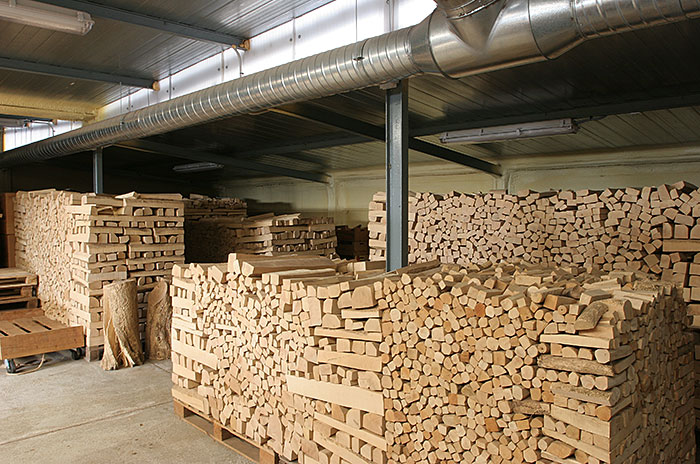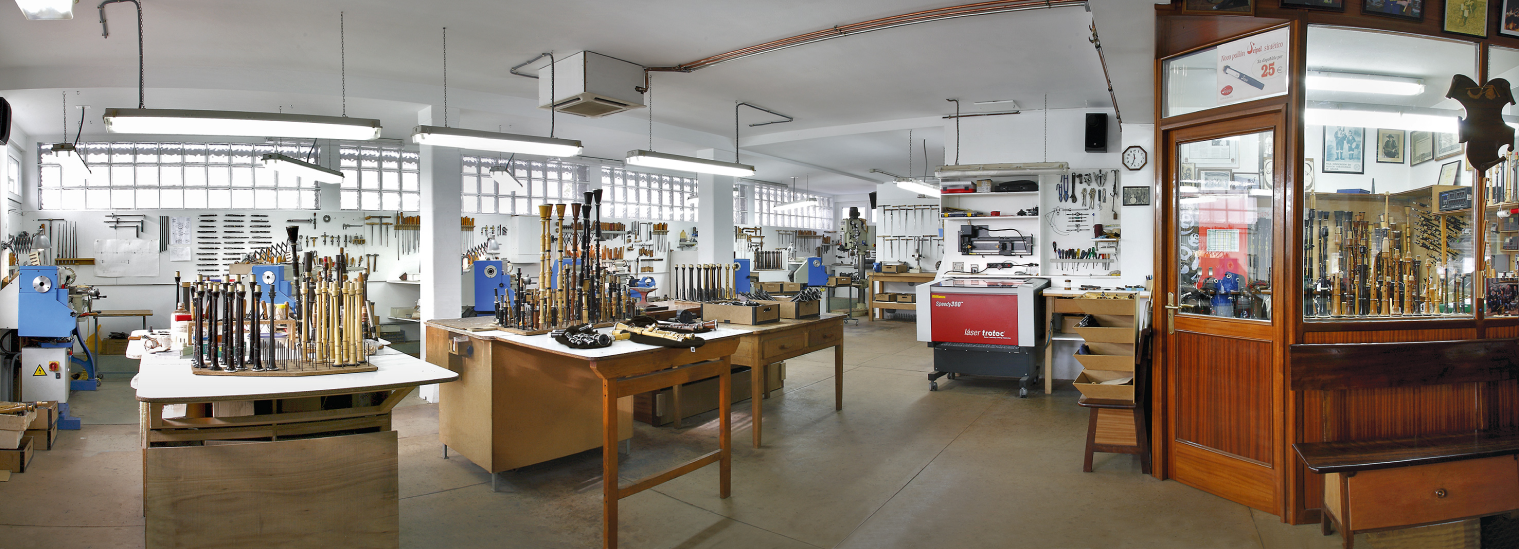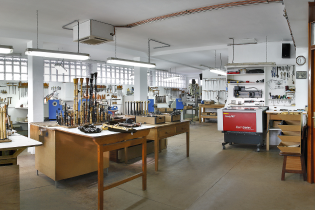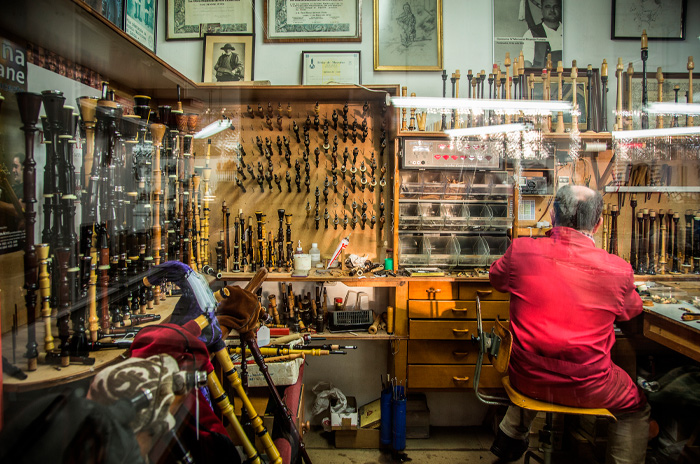- Inicio •
- Obradoiro •
- Installations •
Installations
The Obradoiro de Gaitas Seivane is located near the city of A Coruña, in the municipality of Cambre. This setting was not chosen at random but because of the climate and its strategic position for fast links to the rest of the Region. Historically, A Coruña has been and continues to be the place for the gaita. Great bagpipers were born here and it has enjoyed an intense music revival since the workshop appeared.


Drying Room
This is an acclimatised room in order to allow wood to dry naturally. Taking advantage of favourable climate conditions, external air and the air inside the room automatically flow in and out.
When the climate is not so favourable, the same air circulates around the room. In this way, an air current flows around the strategically stacked tree trunks, but with humidity and temperature maintained at ideal levels for long term natural drying of the wood, which will lead to slow contraction of the wood, avoiding damage to its molecular fibres and the loss of physical and mechanical properties.
This process is totally different to that in industry, where wood is forced to dry in the space of a few months at the expense of its quality.
The wood will remain here for a minimum of ten years drying. Given the stock accumulated over time, in practice it can reach fifteen, twenty or more years in this room, waiting to be used, which favors it, taking hold, and becoming “old wood” as the old carpenters used to say, to extol the virtues of a wood that with the passage of time gains in resistance, stability, tanning and temperance.
Wood Storage Area
This is where previously cylindered and drilled pieces are placed in such a way that air flows within and between them to obtain a perfect oxygenation and drying. The wood will be taken to the workshop several times and will be returned, to allow it to continue resting, settling down and adapting to the modifications which are made to it.
Due to the lack of dust, all pieces that have already been varnished will also be stored here to allow their lacquer to harden.
The wood will remain in this storage area for around five years in an atmosphere where the temperature and humidity are controlled.


The Workshop
This is the most visible part of the Obradoiro, in which all processes are carried out once the wood enters the Wood Storage Area, to which there is a direct link. It is like the kitchen in a traditional house: Everything revolves around it.
The workshop is where all pieces are cylindered, drilled, refined, shaped, ringed, polished and varnished. At the same time, it is also where the characteristic tools used to make gaitas are developed, modified and maintained. Amongst these, the reamers are the most delicate and precise. Their maintenance is continuously, costly and, it can be said that they provide the soul of the chanter as these are used to bore it and apply the internal finishing.
In the metal ring caps section alpaca, silver and brass ring caps are cut, soldered and fixed to the different gaita parts. The carving of wood, tying of stocks to the bag and the addition of corks are also activities that take place within the workshop, as well as the testing of all manner of new materials and prototypes in the constant search for improvement in our instruments.


Tuning Room
This room has been sound proofed and has been set up inside the workshop with which it has a direct relationship. In it, assembly is completed and the final required adjustments are made to each element that makes up the gaitas. Once assembled, they remain here for several days during which various tuning and stability tests are carried out on a daily basis, before being handed over to the bagpiper.
All the sound elements of the gaita, and its sound sources, such as reeds, pass through here at the end of its construction stage, and are fine-tuned.





Technical Office
The characteristic and plain profile of our gaitas is born on drawing boards which are then digitised to achieve the lines and harmonious purity which distinguishes them. The design of our carvings, the dress designs and everything to do with the unmistakable aesthetics of our products, are also created here.
In addition to these specific design activities, the office also has a number control engraving machine, complete with all its accessories, which in addition to making artistic carvings and engravings both on metallic ring caps and wood, brands the pieces with the Seivane logo. This same tool is also used to mark the areas on chanters where the different notes are to be drilled, as well as the year the gaita was made and the mark that identifies the key in which it is tuned.
Fabric & Cords Section
The purpose of this section is the general storage and exhibition of the different types of fabrics, colour charts, linings, cordage, buttons and tassels, with the aim of being able to satisfy the tastes of the most demanding bagpiper.
At the same time, it holds a space for the pattern making, cutting and subsequent elaboration of the different combinations of bag covers, made from linen, velvet, embroidered or with a double pattern. A team of dress makers, specially trained in the Obradoiro de Gaitas Seivane, carry the responsibility for these tasks.


Exhibition & Museum
This area stores a collection of gaitas with different characteristics, keys, combinations of bagpipe covers, fringes, tassels and cords, which were made in the Obradoiro from 1939 to the present day. Amongst them, Susana Seivane’s first gaita stands out, as it was made to measure in the Barcelona workshop when she was only three years old or the last gaita carved by our patriarch, Xosé Manuel Seivane, for his great-grandson Brais, for his first birthday.
Also on display are some of the various awards and distinctions that have been awarded to the Obradoiro or the Seivane family throughout their history, including the highest award for Spanish craftsmanship, the National Crafts Award, for their entire career, or the Castelao Medal from the Xunta de Galicia for his meritorious work.
As well as several flutes, a hurdy gurdy, a violin and other peculiarities.





The Setting
The attractive landscape of the Obradoiro’s surrounding area has to be highlighted. It is possible to visit Celtic relics which are conserved in the Cambre museum and various other buildings belonging to the ancient inhabitants of this area.
Barely a few metres away from the Obradoiro, the ‘Fraga de Cecebre’ can be found, a place chosen by Wenceslao Fernández to add colour to the novel, which would later become a film, ‘El bosque animado’ (‘The animated forest’). Nearby, the Cecebre reservoir, plus the Mero and Barcés rivers can be admired, both of which are unique ecosystems of great beauty.
